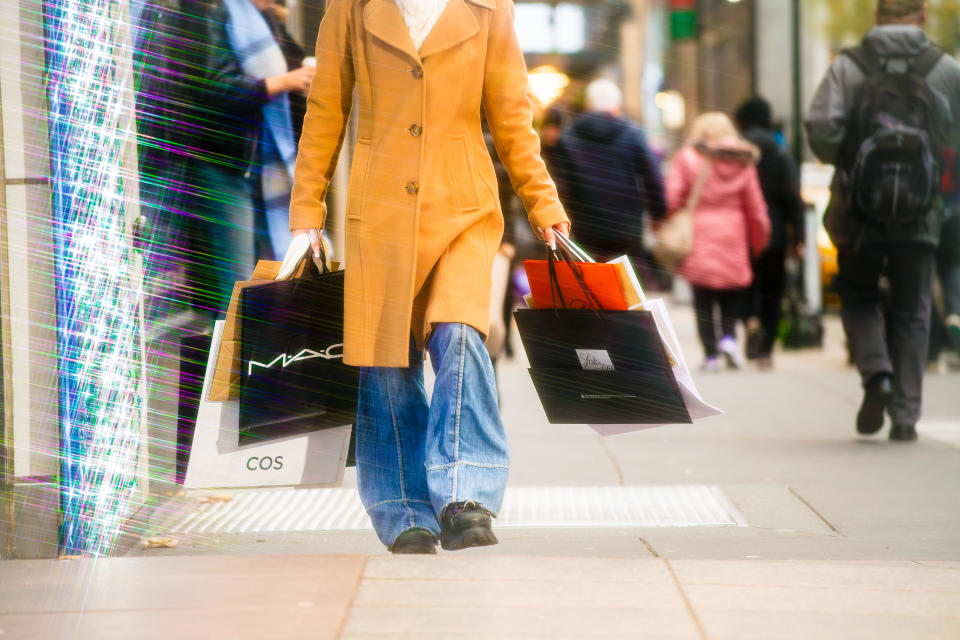Holiday Wrap: Retailers Overcome Uncertainties, Sales Meet Expectations

Though as picky and discount-driven as ever, consumers shopped enough over the course of the season to enable retailers to come out with low-single-digit sales gains, meeting expectations.
U.S. retail sales increased 3.1 percent year-over-year this holiday season, according to preliminary insights from Mastercard SpendingPulse released Tuesday.
More from WWD
EXCLUSIVE: Circana Data Shows General Merchandise Holiday Sales Decline
How the Royal Family Styled King Charles' Highgrove Heritage Scarf for Christmas
Mastercard’s findings are based on in-store and online retail sales across all forms of payment for the Nov. 1 to Dec. 24 period. The figures exclude automotive sales and are not adjusted for inflation, which in the U.S. was 3.1 percent as of last November.
“This holiday season, the consumer showed up, spending in a deliberate manner,” Michelle Meyer, the chief economist at the Mastercard Economics Institute, said in a statement Tuesday. “The economic backdrop remains favorable with healthy job creation and easing inflation pressures, empowering consumers to seek the goods and experiences they value most.”
Slightly under Mastercard’s forecast was one from Customer Growth Partners, the research and consulting firm, which estimated U.S. retail sales for the November to December period at 2.4 percent ahead of last year, above its earlier forecast of 2.1 percent.
“Super Saturday was the number-one day of the year with total sales of $47 billion exceeding the $42.6 billion for Black Friday,” said Craig Johnson, CGP’s president. CGP’s figures do not include restaurant or automotive sales, which could explain why its holiday figure is lower than Mastercard’s.
Mass merchants, off-pricers, outlets, home repair and active/athleisure retailers fared the best this holiday, among them Walmart, Target, Costco, T.J. Maxx, Lululemon, Dick’s Sporting Goods, Academy Sports + Outdoors and Amazon, retail sources told WWD. The National Retail Federation projects a 3 to 4 percent year-over-year growth in sales during November and December, excluding inflation, translating to a spending range of $957.3 billion to $966.6 billion.
This week, retailers look forward to shoppers returning to stores to exchange merchandise and redeem gift cards, including a heavy turnout of kids and teenagers who are off from school. Discounting will be steeper than last week, as retailers look to clear seasonal products to make way for spring goods. That’s about a three-week process going forward. With the mild weather in December, there is a glut of outerwear and cold-weather accessories where discounts should be deep.

In most categories, however, retailers benefited from the largely dry, unseasonably warm weather during the holiday season, favorable for driving to malls. Retailers also benefited from the calendar, with “Super Saturday” falling two days before Christmas, giving consumers a whole weekend before the holiday for last-minute gift shopping. In addition, retailers unleashed holiday campaigns and promotions as far back as October, stretching out the season.
But the whole story on both holiday sales and profits won’t be learned until February and March, when major retailers issue their fourth-quarter results. Still, profits should be OK for the fourth quarter because inventories in most categories were more in line with demand compared to recent years, so promotions this holiday were more targeted and under control. Also, freight and cotton costs were lower this year, helping offset higher labor costs.
“Overall, this holiday season our performance has been in line with expectations,” Rob Brooks, president and chief executive officer of Saks Off 5th, told WWD. “Importantly, our Black Friday event was a standout, exceeding expectations for our digital business. Shoppers this holiday season were looking for value and ease. While we did see some customers shopping earlier, the focus really was around our Black Friday event where we offered a singular sitewide offer in-store and online for the first time. The simplicity of the promotion and strong value offering continued to drive traffic into the Cyber Week period.
“As we got into December, last-minute gifting was apparent with strong demand for key gifting categories such as cold weather, jewelry and accessories,” Brooks added. “Customers responded positively to our offering, particularly designer brands in these areas.”
At the Mytheresa luxury website, “Holiday sales online showed a later shopping pattern than usual, also driven by the weekday constellation,” said CEO Michael Kliger. “Cocktail dresses and gowns showed strong growth. We believe there are many more occasions to get dressed up this year over last. We also saw strong growth on skiwear, while swimwear was weaker. This may indicate less travel abroad by shoppers in the coming weeks than last year. While there was a continued appetite for sale, our top spending customers were much more interested already in the new season styles of spring 2024.”
“Overall, we were pleased with how the season went,” said Ken Ohashi, Brooks Brothers’ CEO. “We had a very strong Black Friday and then there was a lull, but after that, each week was stronger than the prior one, and last week was strong. The customer really came out at the end,” allowing the fashion chain to exceed its 2022 results.
“We saw a nice buildup in November and December versus what happened in the fall,” said Mary Ellen Coyne, CEO of J. McLaughlin. Last week, including Super Saturday, “People were willing to pay full price on things that they think worked for them. “We break sale today [Tuesday] with up to 40 percent markdowns to clear merchandise. Full price returns mid-January. Given what’s been going on in the world, we’re pleased with the results. We stuck to our plan.”
“It was a ho-hum holiday. When the dust settles, a lot of retailers will be satisfied with their results. Most will have met expectations,” said Marshal Cohen, chief retail adviser for Circana, which researches consumer behavior and consults with retailers and brands.
Noting how retailers cautiously managed inventories, Cohen said, “It’s better to keep it low and sell out than to have to sell off. Retailers were more concerned about margins and inventory levels than volume dollars. We didn’t see these huge fire sales or huge inventory dumping that we saw in years past.”
Though retailers often advertised up to 40 or 50 percent off or more, “The majority of sales were actually in the 25 percent range,” Cohen said. “That gives them profitability. When they get into 35 to 40 percent, they start to break even and in some cases lose money.”
Post-Christmas, the discounts will be deeper than 25 percent. Cohen agreed with other retail experts that Super Saturday was a very busy day, although there wasn’t double-digit growth.
Bob Mitchell, co-CEO of Mitchells Family of Stores, said the company ended the holiday period up single digits ahead of 2022, which was a record year for the business. The drivers were women’s and jewelry, he said, with menswear up slightly. While traffic was down from last year, sales were higher.
“The business came later this year with December better than November,” he said. “Luxury was still the winner for us, led by Brunello Cucinelli, Zegna, Kiton, Loro Piana, Brioni and Canali. Jewelry came late but that was the wild card that pushed us over the top.”

Even so, Mitchell said he’s “still very cautious” about 2024. Although the soaring stock market has “given people new confidence, there’s still a lot of uncertainty.…People have bought a lot of the same things from the same brands, so we have to innovate to update our mix of merchandise.”
Ken Giddon, president of Rothmans, a New York-based men’s specialty retailer, was also pleased with how the season ended. “Independent retailers came off our best year last year so we didn’t expect to duplicate those crazy good numbers, especially when we heard the department store business was so challenging,” he said. “But we were pleasantly surprised. I expected to be down with everything going on in the world, but we came in almost at last year’s numbers.”
Giddon said his stores saw a lot of traffic over the holiday period, but instead of big-ticket items, shoppers opted for lower-priced merchandise, such as accessories, T-shirts and sweaters, “not $1,000 coats. We also saw a slowing down of the suit business,” he said, adding that sport coats, jeans and trousers were among the top performers, along with updated dress shirts from brands such as Brax pants, Emanuel Berg and Nice Stuff shirts. “It’s the new dress code,” he said.
At Tanger Outlets, there were some surprises. “Family apparel was a major category,” observed Stephen Yalof, Tanger’s CEO, citing Gap and Old Navy, where business prior to holiday 2023 had been sagging. Other brands, family-oriented or otherwise, that drew good crowds at their outlets were American Eagle Outfitters, Ralph Lauren, Nike, Bath and Body Works, Under Armour, Crocs, Coach, Victoria’s Secret and Ulta, among others Yalof cited.
“People shopped several times during the holiday. They kept on coming out. A lot of consumers chased value,” Yalof said.
Another big surprise was the turnout on the Friday before Super Saturday. “We dubbed it ‘fabulous Friday,'” Yalof said. Super Saturday, he said, was “almost like another Black Friday.”
A third surprise was handbags. “We saw some velocity we hadn’t seen before,” Yalof said. In addition, “athletic brands, despite Nike’s report, still seemed to do well,” the CEO said, referring to Nike’s grim forecast reported last Thursday. Yalof develops his holiday insights based his shopping center managers filling out a survey on what they saw and speaking with store managers and shoppers.
“Traffic was strong last weekend. We were definitely pleased,” said Stephen Lebovitz, CEO of CBL Properties, the Chattanooga, Tenn.-based real estate investment trust with a total of 94 malls, and open-air, lifestyle and outlet centers. “Friday was as strong as Saturday, Sunday was not as strong but still strong. There were a lot of last-minute shoppers, and more men with children than we saw earlier in the season. There were some uncertainties and questions about spending but shoppers came through for us. The economy is still strong. Unemployment is low. Inflation has been getting lower. The weather was good. The promotions seemed to be targeted but effective. People had plenty of time to get the presents they needed. A combination of factors worked in our favor.”
Lebovitz cited cosmetics, shoes, athleisure, “giftable” jewelry, as well as Yeti coolers, as popular gifts. He expects another big business period this week, with the weather expected to be mild in most parts of the country, apart from the major winter storm in the Plains states; students off school, and those visiting malls not just there to return or exchange gifts or redeem gift cards. They’re there for the entertainment as well, whether visiting Dave & Busters, or to see a movie, he said.
This year’s holiday calendar supported last-minute shopping, with Super Saturday falling on the day before Christmas Eve.”
Cederick Johnson, MRI Software
Evan Gold, executive vice president of Planalytics, which forecasts weather and uses that to help retailers in their planning, said, “It was the warmest Super Saturday in at least 10 years. It was very dry. There was nothing stopping people from getting to the stores, but from a seasonal demand perspective, outerwear, sweaters, hats, gloves were down because of the warmth, and in many cases the demand was shifted to home goods and gift cards,” Gold said. “It’s still going to be warm for most of this week and into next week but most of January will be colder than last year. It will be a good opportunity to clear winter goods.”
Meredith German, founder of the Lewisburg Surf Shop in Lewisburg, W.Va., described the store’s second holiday season as “quite consistent.”
To rev up interest, the retailer did pop-ups in Houston, San Antonio, Texas, and Pittsburgh early in the season. German said, “It’s always fun to see what customers are buying in other markets and we had a lot of success with festive pieces for holiday dressing. When we travel we take our New York City-based handbag brand Bienen Davis. This season we had a lot of bespoke orders for future events and weddings. As we got closer to Christmas, our local customers were more focused on gift giving.”
True to the store’s very ’80s-inspired decor, bright and nostalgic styles were popular as well as unique jewelry and accessories like Hillier Bartley paper-clip earrings, Roxanne Assoulin starburst bracelets and Grand Azure sunglasses.
Having moved back to her hometown during the pandemic, she enjoys being part of Lewisburg’s new incarnation and plans to try to make the store easier to find. Lewisburg Surf Shop also has an online store.
Taylor Swift’s influence on fashion continues, according to German. “I would definitely describe this holiday season as ‘Swiftmas!’ We sold so many Taylor Swift ornaments on our website. It was also a great year for Barbie books and ornaments. The power of nostalgia around gift giving always amazes me.”
Recapping the bestsellers of the season, Ohashi said shoppers responded to Brooks’ “fashion” offering, which translates into updated classic pieces in trend-right colors and patterns. “We’re never going to be fast fashion. But we’re selling more seasonal colors, patterns and silhouettes.” That includes merino and cashmere sweaters as well as suits that creative director Michael Bastian tweaked to be more fashion forward.

Womenswear was also a big winner, Ohashi said, where Bastian updated the assortment to refocus on luxury and career offerings. “Coming out of COVID-19, customers replenished basics, but this year they’re focused on fashion,” Ohashi said. “We also maintained our promotional posture and our inventories are well controlled. So we’re cautiously optimistic about 2024. We had a very strong first half of last year so we were up against that, but we’re up over last year now. For next year, we want to plan conservatively and then beat it.”
J.McLaughlin cofounder and chief creative director Kevin McLaughlin said men’s sweaters and outerwear sold well, while McLaughlin’s bucket bags with black bamboo handles were standouts. In women’s, tailored button-front blouses as well as sweaters, dresses and pants did well.
According to CGP’s Johnson, the weather being “benign” helped traffic, but from a merchandise point of view, “sales in winter gear, outerwear, scarves, gloves and beanies were very muted. Over the last week or 10 days there have been extensive markdowns in those categories.”
On the other hand, the weather supported sporting goods, resort wear and swimwear sales, Johnson said. “Home improvement did a little better because you could work outside…All things considered, this was a decent holiday, not a barn-burner, marking a normalization of Christmas shopping patterns. The 10-year CAGR [compound annual growth rate] for holiday sales is 5.4 percent. Half of that percent growth marks a return. Very few retailers had oversupplies of inventory. so we think retailers on average will see improved profitability. The only ones harmed are department and specialty stores that made a big bet on outerwear.”
According to MRI Software, a real estate technology firm that tracks footfall, on Super Saturday, pedestrian traffic in New York City was up 0.7 percent from Super Saturday in 2019. In major downtowns across the U.S., Super Saturday traffic was down 9.1 percent from Super Saturday in 2019.
Year-over-year, Super Saturday traffic was up 54.7 percent in New York City from Super Saturday 2022, and up 60.6 percent in downtown locations in major cities from Super Saturday 2022. Those big percent jumps were largely due to the calendar shift.
“This year’s holiday calendar supported last-minute shopping, with Super Saturday falling on the day before Christmas Eve, in contrast to last year’s Super Saturday, which took place on Dec. 17. Christmas Eve in 2022 fell on a Saturday,” whereas this year it fell on a Sunday, explained Cederick Johnson, MRI Software’s senior director, brand and communications.
“Yet the calendar only partly explains the significant increases in pedestrian traffic on Super Saturday, both nationally and in New York City downtowns,” Johnson added. “The jumps are encouraging, as is the comparison between New York City’s downtown traffic in 2023 and 2019. The latter data indicates that one of the world’s busiest shopping meccas is returning to pre-pandemic norms.”
— With contributions from Jean E. Palmieri and Rosemary Feitelberg
Ten Holiday 2023 Trends
Retailers meet expectations, averaging low single-digit sales gains.
Consumer spending was resilient, marked by vigilant deal-hunting to offset inflation.
Clothing, gift cards, beauty, toys, food/candy, books, games, sporting goods were top sellers
Weak sales on outerwear, winter gear.
Retailers confident they got their inventories mostly right, helping margins.
Off-pricers, outlets, mass merchants, home repair, and active/athleisure retailers fared the best
Price promoting early, heavier online, but targeted and controlled
Cyber Week, Super Saturday and the two days before Christmas generated strong traffic.
Buy now, pay later saw increased usage
Holiday mood muted, not frenzied.
Best of WWD

